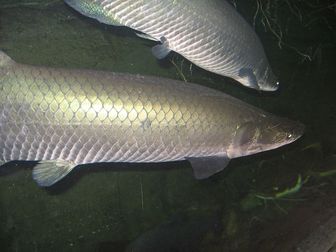Arapaima
Arapaima can reach lengths of more than 2 m , in some exceptional cases even more than 2.

Original source: Own work Author Ginkgo100 Permission (
Author: Ginkgo100 Permission (
Permission: GNU Free Documentation License
The Arapaima lives in the demersal, freshwater, pH range: 6.0 - 6.5, dH range: 10 environment.
Arapaima - South America's Living Fossil
 The Arapaima (Arapaima gigas) is known as a living fossil because there exists a fossil of this species or one very close to it in Colombia. Living fossils often are only known because of the similarity in the fossils already found, because they have no other living species that resemble them. It is usually speculated that living fossils like the arapaima were around during catastrophic events in prehistory that led to the extinction of many other species.
The Arapaima (Arapaima gigas) is known as a living fossil because there exists a fossil of this species or one very close to it in Colombia. Living fossils often are only known because of the similarity in the fossils already found, because they have no other living species that resemble them. It is usually speculated that living fossils like the arapaima were around during catastrophic events in prehistory that led to the extinction of many other species.
The arapaima’s origins are said to be in Brazil, where it thrives in the fresh water of the Amazon basin. It is also found in other parts of South America, such as Argentina. Thailand and Malaysia also are home to the arapaima, where they live in local lakes, though they were introduced to these countries and are not native to them.
Out of all of the freshwater fish in the world, the arapaima is one of the largest. This fish can reach 2 meters in length or 6.6 feet, and can weigh more than 100 kilograms, or 220 pounds. Some can even grow to be 2.5 meters or 8.2 feet long. It is a unique species because it needs air to breathe, so it survives best in the shallower waters of the Amazon. In deeper waters it can be seen coming to the surface to take in air.
People in the arapaima’s native region love its meat. The flesh of the fish has a reputation for being very tasty, and arapaimas are eaten frequently in Brazil. It is also sought after in South America for other uses, including those that are medicinal in nature. According to local folk traditions, the fish’s tongue has healing properties. Supposedly if you dry the fish’s tongue and prepare it with a certain native bark by adding both to water, this mixture will get rid of parasitic worms. Locals also fashion nail files out of the arapaima’s scales. As for its own diet, it is a fierce freshwater predator, eating not only other fish and crustaceans but even some small birds.
Because it is so popular for both food and other uses, it is widely fished and has reached the Vulnerable stage on the extinction scale. If present trends as far as fishing rates and the destruction of its Amazon habitat continue, the fish will reach the Endangered stage on the scale.
Common names
arapaima in Danish (dansk)
arapaima in English
arapaima in Finnish (suomen kieli)
Arapaïma in French (français)
arapaima in German (Deutsch)
arapaima in Lithuanian (lietuvių kalba)
arapaima in Polish (polski)
arapaima in Russian (русский язык)
arapaima in Spanish (español)
arapaima in Swedish (Svenska)
Arapaima gigas in Dutch (Nederlands)
Arapaima gigas in French (français)
Arapaima gigas in Italian (Italiano)
Arapaima gigas in Norwegian (Norsk)
Arapaima velká in Czech (česky)
Arapajma obrovská in Czech (česky)
Arapayma in Turkish (Türkçe)
Bodeco in Portuguese (Português)
giant arapaima in English
Paiche in French (français)
Paiche in German (Deutsch)
Paiche in Spanish (español)
Piracurù in German (Deutsch)
Pirarucu in English
Pirarucu in French (français)
Pirarucu in Portuguese (Português)
Pirarucu in Unknown
Piraruku in Guarani (Avañe'ẽ)
Αραπαΐμα in Greek (Ελληνικά)
Арапайма in Russian (русский язык)
არაპაიმა in Georgian (ქართული)
巨巴西骨舌魚(引進) in Mandarin Chinese
巨巴西骨舌鱼(引进) in Mandarin Chinese


Family : Arapaimidae
Genus : Arapaima
Species : Arapaima gigas
Authority : Schinz, 1822
